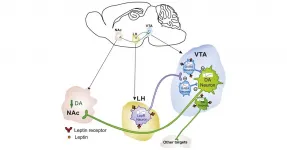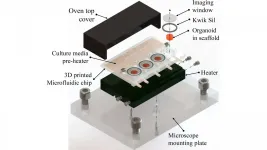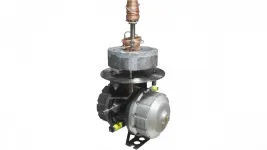Novel biomarker for glucocorticoids could help tailor treatments
A clinical study finds a biomarker for the action of glucocorticoids that could be used for developing tests to help clinicians tailor treatments
2021-04-06
(Press-News.org) Researchers have uncovered pathways involved in the body's response to glucocorticoid treatments and identified a novel biomarker that could be used to monitor how these drugs work in patients, according to a clinical study published today in eLife.
A more reliable indicator of an individual's response to glucocorticoid drugs could be used to develop a clinically applicable test that could help tailor treatments and potentially minimise side-effects.
Glucocorticoids, such as cortisol, are a type of hormone with key roles in the body's response to stress. Glucocorticoid drugs are one of the most commonly prescribed treatments for a range of conditions, including for patients whose adrenal glands are unable to produce enough cortisol. The effects of glucocorticoids are complex, meaning the level of cortisol in the blood does not reliably reflect what is happening in the tissues. This makes it hard for medical professionals to know how to tailor treatments.
"Side effects of glucocorticoid treatments are common in patients, indicating that current methods to monitor their action, which typically focus on clinical response or disease activity, are inadequate," explains first author Dimitrios Chantzichristos, Head Physician at the Section for Endocrinology-Diabetes-Metabolism, Sahlgrenska University Hospital, Sweden. "We wanted to find some kind of biomarker that could be measured to monitor the action of glucocorticoids in individuals, with the hopes this will help clinicians understand how best to treat patients."
The team studied patients with Addison's disease who lack the ability to produce their own cortisol. This allowed them to compare the activity in the tissues of the same patient both when their cortisol levels were low and when they were being restored by glucocorticoid treatments, helping account for variations between individuals.
Rather than focusing only on the metabolic products associated with glucocorticoid exposure, they also looked at gene expression and microRNAs in the patients using new computational approaches developed in collaboration with Dr Adam Stevens at the University of Manchester, UK. MicroRNAs are short strands of ribonucleic acid (RNA) that can regulate the expression of genes by interfering with protein production. The team analysed these different factors in blood cells and body fat, an important metabolic tissue, as the patients' cortisol levels were changed, revealing close relationships between different elements involved in glucocorticoid action.
Among the elements they identified, a microRNA called miR-122-5p closely correlated with genes and metabolites that are regulated by the glucocorticoid treatments. To test this correlation, the team looked at miR-122-5p levels in blood from patients exposed to different levels of glucocorticoids from three independent studies and found the same pattern, supporting the idea that this microRNA could be a useful biomarker of glucocorticoid action.
"This potential biomarker can now be investigated in larger groups of patients with the aim to develop a clinically applicable test," concludes senior author Gudmundur Johannsson, Professor at the Department of Internal Medicine and Clinical Nutrition, University of Gothenburg, Sweden. "Our work has also increased our understanding of the action of glucocorticoids, which may help uncover their role in many common diseases such as diabetes, obesity and cardiovascular diseases."
INFORMATION:
This study was a collaborative effort between researchers at the Universities of Manchester (UK), Edinburgh (UK), Copenhagen (Denmark) and Gothenburg (Sweden), as well as Newcastle University (UK) and Sahlgrenska University Hospital (Sweden).
Media contact
Emily Packer, Media Relations Manager
eLife
e.packer@elifesciences.org
+44 (0)1223 855373
About eLife
eLife is a non-profit organisation created by funders and led by researchers. Our mission is to accelerate discovery by operating a platform for research communication that encourages and recognises the most responsible behaviours. We aim to publish work of the highest standards and importance in all areas of biology and medicine, including Computational and Systems Biology, and Medicine, while exploring creative new ways to improve how research is assessed and published. eLife receives financial support and strategic guidance from the Howard Hughes Medical Institute, the Knut and Alice Wallenberg Foundation, the Max Planck Society and Wellcome. Learn more at https://elifesciences.org/about.
To read the latest Computational and Systems Biology research published in eLife, visit https://elifesciences.org/subjects/computational-systems-biology.
And for the latest in Medicine, see https://elifesciences.org/subjects/medicine.
Full list of funders for this study:
Vetenskapsrådet, The Swedish federal government under the LUA/ALF agreement, The Swedish Endocrinology Association, Gothenburg Medical Society, Wellcome Trust, Medical Research Council, Chief Scientist Office, The Eva Madura's Foundation, Rigshospitalet, Danish Rheumatism Association
ELSE PRESS RELEASES FROM THIS DATE:
2021-04-06
Researchers from Skoltech and their collaborators have designed, synthesized and evaluated new compounds that can serve as catholytes and anolytes for organic redox flow batteries, bringing this promising technology closer to large-scale implementation. The two papers were published in the END ...
2021-04-06
A new U.S. Geological Survey study provides an updated, statewide estimate of high levels of naturally occurring arsenic and uranium in private well water across Connecticut. This research builds on a USGS report published in 2017, with the new study including additional groundwater samples and focusing on previously underrepresented areas.
The research, undertaken in cooperation with the Connecticut Department of Public Health, projects that approximately 3.9% of private wells across Connecticut contain water with arsenic at concentrations higher than the U.S. Environmental Protection Agency's maximum contaminant level for ...
2021-04-06
Sea urchins receive a lot of attention in California. Red urchins support a thriving fishery, while their purple cousins are often blamed for mowing down kelp forests to create urchin barrens. Yet for all the notice we pay them, we know surprisingly little about the microbiomes that support these spiny species.
Researchers at UC Santa Barbara led by geneticist Paige Miller sought to uncover the diversity within the guts of these important kelp forest inhabitants. Their results reveal significant differences between the microbiota of the two species, as well as between individuals living ...
2021-04-06
Philadelphia, April 6, 2021 - Since the discovery of leptin in the 1990s, researchers have wondered, how does leptin, a hormone made by body fat, suppress appetite? Despite tremendous gains in the intervening three decades, many questions still remain. Now, a new study in mice describes novel neurocircuitry between midbrain structures that control feeding behaviors that are under modulatory control by leptin. The study appears in Biological Psychiatry, published by Elsevier.
John Krystal, MD, Editor of Biological Psychiatry, said of the findings, "Omrani and colleagues shed light on how, in non-obese animals, leptin puts the brakes on overeating."
Leptin acts as a critical link between the body and the brain, providing information about metabolic ...
2021-04-06
In addition to smoothing out wrinkles, researchers have found that the drug Botox can reveal the inner workings of the brain. A new study used it to show that feedback from individual nerve cells controls the release of dopamine, a chemical messenger involved in motivation, memory, and movement.
Such "self-regulation," the researchers say, stands in contrast to the widely held view that the release of dopamine -- known as the "feel good" hormone -- by any cell relied on messages from nearby cells to recognize that it is releasing too much of the hormone.
Led by researchers at NYU Grossman School of Medicine, ...
2021-04-06
WASHINGTON, April 6, 2021 -- Scientists from MIT and the Indian Institute of Technology Madras have grown small amounts of self-organizing brain tissue, known as organoids, in a tiny 3D-printed system that allows observation while they grow and develop. The work is reported in Biomicrofluidics, by AIP Publishing.
Current technology for real-time observation of growing organoids involves the use of commercial culture dishes with many wells in a glass-bottomed plate placed under a microscope. The plates are costly and only compatible with specific microscopes. They do not allow for the flow or replenishment of a nutrient medium to the growing tissue.
Recent advances have used a technique known as microfluidics, where a nutrient ...
2021-04-06
WASHINGTON, April 6, 2021 -- Cryocoolers are ultracold refrigeration units used in surgery and drug development, semiconductor fabrication, and spacecraft. They can be tubes, pumps, tabletop sizes, or larger refrigerator systems.
The regenerative heat exchanger, or regenerator, is a core component of cryocoolers. At temperatures below 10 kelvins (-441.67 degrees Fahrenheit), performance drops precipitously, with maximum regenerator loss of more than 50%.
In their paper, published in Applied Physics Letters, by AIP Publishing, researchers at the University of Chinese Academy of Sciences used ...
2021-04-06
WASHINGTON, April 6, 2021 -- Dragonfly wings, lotus leaves, cicada wings -- thanks to millennia of evolution, nature has optimized the ways these surfaces and others behave to offer antibacterial functionality.
An international, interdisciplinary team of researchers is trying to find the best way to translate these features to create nature-inspired bactericidal surfaces for use in medical implants. They discuss the surface structures and chemical compositions for an ideal implant material in the journal Applied Physics Reviews, from AIP Publishing.
"Objects in ...
2021-04-06
What The Study Did: Researchers compared the effectiveness of case-based (including contact tracing and quarantine) and population-based (including social distancing and facial masking) interventions for COVID-19 containment in Taiwan, one of the few countries with initial success in COVID-19 control without strict lockdown or school closure.
Authors: Hsien-Ho Lin, M.D., Sc.D., of National Taiwan University in Taipei, Taiwan, is the corresponding author.
To access the embargoed study: Visit our For The Media website at this link https://media.jamanetwork.com/
(doi:10.1001/jamainternmed.2021.1644)
Editor's Note: The article includes conflicts of interest and funding/support disclosures. Please see the article for additional information, including ...
2021-04-06
What The Study Did: This study investigated the role of droplet or contact transmission in the development of Kawasaki disease in Japan during the COVID-19 state of emergency. Kawasaki disease primarily affects children and is characterized by fever and swelling in the walls of some blood vessels.
Authors: Toshiro Hara, M.D., Ph.D., of the Fukuoka Children's Hospital in Fukuoka, Japan, is the corresponding author.
To access the embargoed study: Visit our For The Media website at this link https://media.jamanetwork.com/
(doi:10.1001/jamanetworkopen.2021.4475)
Editor's Note: The article includes conflicts of interest and funding/support disclosures. Please see the article for additional information, ...
LAST 30 PRESS RELEASES:
[Press-News.org] Novel biomarker for glucocorticoids could help tailor treatments
A clinical study finds a biomarker for the action of glucocorticoids that could be used for developing tests to help clinicians tailor treatments



